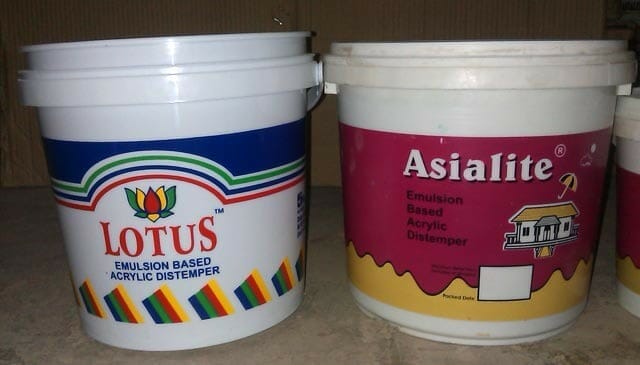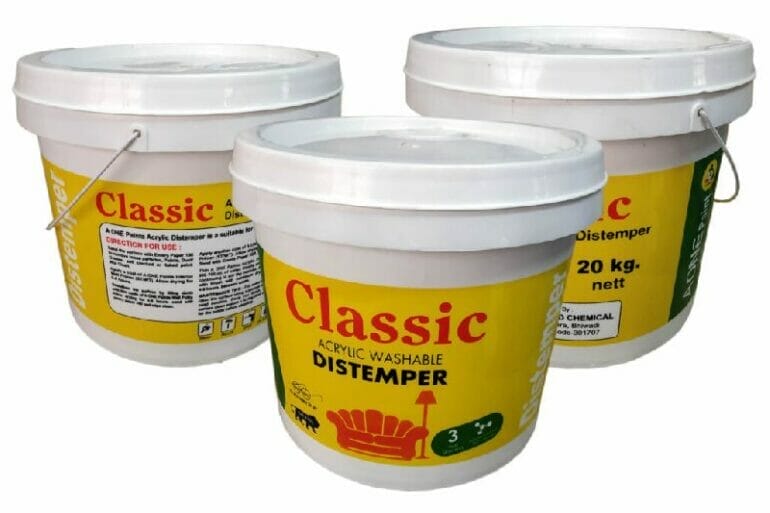Yes, acrylic paint is washable. It can be easily cleaned with soap and water while it is still wet. However, once dried, acrylic paint forms a permanent and waterproof layer that cannot be easily washed off. This makes it ideal for various art projects, crafts, and even for painting on fabrics that may need to be washed.

Protecting Your Acrylics: How to Make Acrylic Paint Washable
Acrylic paint is a versatile and popular medium used by artists of all skill levels. Whether you’re creating a masterpiece on canvas or working on a DIY project, acrylic paint offers vibrant colors and a smooth finish. However, one downside of acrylic paint is that it can be difficult to remove from surfaces once it dries. If you’re looking to protect your acrylics and make them washable, follow these tips:
1. Choose the Right Surface
When working with acrylic paint, the surface you choose can affect how washable your artwork or project will be. Opt for non-porous surfaces such as glass, metal, or plastic, as these are easier to clean. If you’re painting on a porous surface like wood or fabric, consider applying a primer or sealant to create a barrier before painting.
2. Use a Sealant or Varnish
To protect your acrylic paint and make it more washable, apply a sealant or varnish once your artwork is complete. A sealant acts as a protective barrier, preventing the paint from absorbing moisture or becoming stained. Choose a sealant that is specifically designed for acrylic paint, as other types may not adhere properly.
Before applying the sealant, make sure your painting is completely dry. Follow the manufacturer’s instructions for application, ensuring you cover the entire surface evenly. Allow the sealant to dry thoroughly before handling or washing your artwork.
3. Avoid Excessive Water
While acrylic paint is water-based and can be thinned with water, excessive moisture can make it more difficult to remove once it dries. When cleaning your acrylic paint, avoid using excessive water or soaking the surface. Instead, gently wipe the surface with a damp cloth or sponge.
4. Use Mild Soap and Water
If you need to clean your acrylic paint, use mild soap and water. Avoid harsh cleaning agents or solvents, as these can damage the paint or surface. Mix a small amount of mild soap with water and gently scrub the painted surface. Rinse with clean water and pat dry with a soft cloth.
5. Test Before Washing
Before washing your acrylic paint, it’s always a good idea to test a small, inconspicuous area to ensure the paint does not come off or get damaged. This is particularly important if you’re cleaning a painted surface that is not meant to be washable, such as furniture or walls.
6. Store Properly
To prolong the life of your acrylic paint and ensure it remains washable, it’s essential to store it properly. Keep your paint tubes tightly sealed when not in use to prevent them from drying out. Store them in a cool, dry place away from direct sunlight.
Additionally, if you have leftover paint, transfer it to an airtight container to prevent it from drying out. Label the container with the color and date for easy reference in the future.
Summary
Protecting your acrylics and making them washable is not only important for preserving your artwork but also for maintaining the integrity of your painted surfaces. By choosing the right surface, using a sealant or varnish, avoiding excessive water, using mild soap and water for cleaning, testing before washing, and storing your paint properly, you can ensure that your acrylic paint remains vibrant and washable for years to come.

The Ultimate Guide to Washable Acrylics: FAQs and Tips
Acrylic paint has become a popular choice for artists and hobbyists alike due to its versatility and vibrant colors. However, one downside of using acrylics is that they can be challenging to clean once they dry. This is where washable acrylics come in, offering a convenient solution for those who want to enjoy the benefits of acrylic paint without the hassle of difficult cleanup.
What are Washable Acrylics?
Washable acrylics are a type of acrylic paint that can be easily removed from surfaces with soap and water, even after they have dried. Unlike traditional acrylics, which require solvents or harsh chemicals for cleanup, washable acrylics allow you to clean your brushes, palettes, and other tools effortlessly, making them an ideal choice for artists of all levels.
How do Washable Acrylics Work?
The secret behind washable acrylics lies in their unique formulation. These paints are made with a water-soluble binder that allows them to be easily dissolved with water. This means that once the paint dries, you can simply wet the surface and gently scrub it to remove the paint.
Tips for Using Washable Acrylics
While washable acrylics offer a convenient cleanup process, there are a few tips and tricks you can follow to make the most out of your painting experience:
- Prep your tools: Before starting your painting session, make sure to prepare your brushes, palettes, and other tools by wetting them with water. This will help prevent the paint from drying too quickly and becoming difficult to clean.
- Work on non-absorbent surfaces: Using washable acrylics on non-absorbent surfaces such as glass or plastic can make the cleanup process even easier. These surfaces can be effortlessly wiped clean with a damp cloth or sponge.
- Use a palette with a lid: Invest in a palette with a lid or cover to keep your paints moist during breaks. This will prevent them from drying out and minimize the risk of having stubborn dried paint to clean later.
- Clean up immediately: To ensure the best results, it’s important to clean up any spills or accidental brush strokes as soon as possible. The longer the paint sits, the more difficult it can be to remove.
- Experiment with different techniques: Washable acrylics can be used for various techniques, including glazing, layering, and impasto. Don’t be afraid to explore different styles and methods to unleash your creativity.
Advantages of Washable Acrylics
Washable acrylics offer several advantages over traditional acrylic paints:
- Easy cleanup: The main advantage of washable acrylics is their effortless cleanup process. With just soap and water, you can quickly remove paint from brushes, surfaces, and other tools without the need for harsh chemicals or solvents.
- Non-toxic: Most washable acrylics are non-toxic, making them safe to use for artists of all ages. This is especially beneficial for those who work in shared spaces or have children who enjoy painting.
- Cost-effective: Washable acrylics are typically more affordable than their traditional counterparts. This makes them a great option for beginners or artists on a budget.
- Wide range of colors: Washable acrylics come in a wide array of colors, allowing artists to explore their creativity and create vibrant artworks.
In Summary
Washable acrylics are a game-changer for artists who want to enjoy the benefits of acrylic paint without the hassle of difficult cleanup. Their water-soluble formulation and easy-to-clean nature make them a convenient choice for artists of all levels. By following a few tips and tricks, you can make the most out of your washable acrylics and unleash your creativity without worrying about the cleanup process.

Washability 101: Understanding the Rinseability of Acrylic Paints
Acrylic paints are a popular choice among artists and crafters due to their versatility and vibrant colors. However, one factor that often comes into consideration when working with acrylic paints is their washability. In this section, we will delve deeper into the concept of rinseability and how it affects your artwork and cleaning process.
1. What is Rinseability?
Rinseability refers to the ease with which acrylic paints can be washed off different surfaces. It is a measure of how well the paint can be removed using water or other cleaning agents. Understanding the rinseability of acrylic paints is crucial for several reasons, including the maintenance of your brushes, cleaning up accidental spills, and even washing your hands after a painting session.
2. Factors Affecting Rinseability
The rinseability of acrylic paints can be influenced by several factors. These factors include:
- Pigment Density: Acrylic paints with a higher pigment density may require more effort to rinse off.
- Paint Thickness: Thicker layers of acrylic paint can be more challenging to remove compared to thinner layers.
- Surface Porosity: The porosity of the surface on which the paint is applied can affect rinseability. Non-porous surfaces like glass or plastic may allow for easier removal of paint compared to porous surfaces like canvas or fabric.
- Paint Additives: Certain additives like mediums or gels can alter the rinseability of acrylic paints. Some additives may increase the paint’s adhesion to the surface and make it more difficult to rinse off.
3. Tips for Improving Rinseability
If you encounter issues with the rinseability of your acrylic paints, there are a few tips you can try to improve the cleaning process:
- Preparation: Before starting your painting session, it’s a good idea to prepare your workspace and have water and cleaning materials readily available.
- Thinning the Paint: Diluting the acrylic paint with water or a thinning medium can make it easier to rinse off surfaces.
- Immediate Cleaning: Try to clean up any spills or drips as soon as they occur. Fresh paint is typically easier to remove than dried paint.
- Soaking Brushes: If you’re having trouble cleaning your brushes, you can soak them in water or a specialized brush cleaner to help loosen the paint.
- Using Gentle Cleaning Agents: For stubborn paint stains, you can use mild soap or specialized acrylic paint removers to assist with the cleaning process. Avoid using harsh chemicals that may damage the surface or your artwork.
4. Testing Rinseability
Before using acrylic paints on a specific surface or material, it’s always a good practice to test the rinseability. Apply a small amount of paint and try to wash it off using water or the recommended cleaning agent. This will give you an idea of how easily the paint can be removed and allow you to make any necessary adjustments to your painting process.
5. Importance of Rinseability in Artwork
The rinseability of acrylic paints plays a crucial role in the maintenance and preservation of artwork. If paints are not thoroughly rinsed off brushes or surfaces, they can dry and harden, making it difficult to achieve the desired results in future painting sessions. Additionally, proper cleaning and removal of paint can help prevent unwanted color mixing and contamination.
In summary, understanding the rinseability of acrylic paints is essential for artists and crafters alike. By considering factors such as pigment density, paint thickness, surface porosity, and paint additives, you can make informed decisions about the ease of cleaning and maintenance of your artwork. Following the tips mentioned above and performing rinseability tests will ensure a smoother painting process and better longevity of your materials.
5. Mess-Free Painting: The Benefits of Using Washable Acrylics
When it comes to painting, one of the biggest concerns is the mess it can create. Spilled paints, stained clothes, and messy cleanup can be quite discouraging, especially for beginners or those with young children. However, there is a solution to this problem – washable acrylics.
Washable acrylics offer a range of benefits that make painting a mess-free and enjoyable experience. Whether you are an artist or a parent looking to engage your child in a creative activity, using washable acrylics can make a significant difference. Let’s explore the benefits of using washable acrylics:
1. Easy Cleanup
Unlike traditional acrylic paints, washable acrylics can be easily cleaned up with just water and soap. Whether the paint has spilled on your clothes, furniture, or even walls, you can simply wipe it off with a damp cloth or sponge. This makes washable acrylics an excellent choice for indoor painting projects, as it eliminates the stress and effort of dealing with stubborn stains.
2. Safe for Kids
If you have children who love to paint, washable acrylics are a great option. These paints are non-toxic and safe for kids to use. You won’t have to worry about harmful chemicals or fumes, making it a worry-free activity for both children and parents. Additionally, the easy cleanup makes it ideal for messy little artists.
3. Versatility
Washable acrylics offer the same versatility and range of colors as traditional acrylic paints. Whether you are working on canvas, paper, or any other surface, you can achieve vibrant and professional-looking results. The paints can be mixed, layered, and thinned, allowing you to experiment with different techniques and achieve various textures.
4. Quick Drying Time
One of the advantages of washable acrylics is their quick drying time. Unlike oil paints that can take days or even weeks to dry, washable acrylics dry within minutes. This allows you to work on multiple layers or make adjustments to your artwork without having to wait for extended periods. It is particularly beneficial for those who prefer a more spontaneous and fast-paced painting process.
5. Long-lasting Results
Don’t let the term “washable” fool you – washable acrylics offer long-lasting and durable results. Once the paint has dried, it becomes water-resistant and resistant to fading. This ensures that your artwork remains vibrant and intact for years to come. You can confidently display or sell your paintings without worrying about them losing their original beauty.
In summary, using washable acrylics provides numerous benefits for artists and those looking for a mess-free painting experience. The easy cleanup, safety for kids, versatility, quick drying time, and long-lasting results make washable acrylics a popular choice. So, whether you are a professional artist or someone looking to nurture their creative side, consider using washable acrylics for an enjoyable and hassle-free painting experience.
FAQs
Is acrylic paint washable?
Yes, acrylic paint is washable. While wet, it can be easily removed from surfaces with soap and water. However, once it dries, acrylic paint becomes water-resistant and may require mild solvents or specialized cleaners for removal.
Conclusion:
In conclusion, acrylic paint is indeed washable, making it a versatile choice for various art projects and crafts. Its water-based formulation allows for easy clean-up with soap and water, eliminating the need for harsh chemicals or solvents. Additionally, acrylic paint’s washability extends to fabric, making it suitable for painting on clothing and other textiles. Whether you’re a professional artist or a hobbyist, the ability to wash away mistakes and spills is a valuable feature of acrylic paint. So, go ahead and experiment with this vibrant and forgiving medium with confidence.
